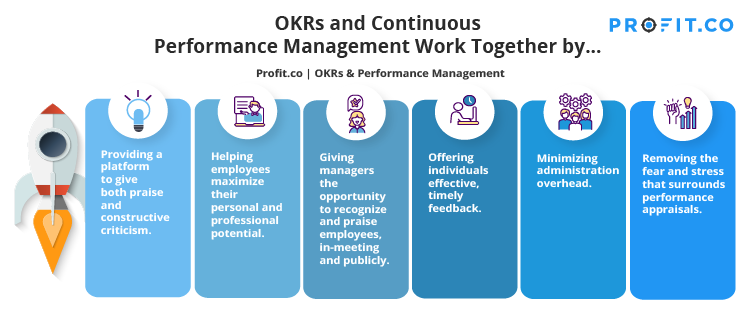Many organizations are changing the way that they manage their goals and evaluate their employees. This can be a tedious process, and changing up the flow of your organization can seem like a big leap of faith into a lot of unknowns. Today, we’re going to clarify one of these unknowns for you by answering the following question: can OKRs and continuous performance management work together?
We’ll begin by taking a quick look at what the OKR framework and continuous performance management are, respectively.
Appreciate everything your associates do for the business. Nothing else can quite substitute for a few well-chosen, well-timed, sincere words of praise.
OKRs
What are OKRs?
Objectives and key results is a goal-setting framework used to define high-priority goals and track quantitative outcomes in your organization.
OKRs can help managers gain insight into what goals employees are working towards, and help inform performance reviews with context about employees’ priorities. That being said, OKRs cannot be used as a sole indicator of performance and should not be linked to any compensation discussions.
Continuous performance management
Continuous performance management (CPM) is a newer approach to performance management that is slowly growing in popularity. This method is replacing more traditional systems such as the annual review. Unlike annual performance reviews, though, continuous performance reviews are ongoing discussions / reviews between managers and employees with a focus on communication, feedback ,and personal development.
OKRs and continuous performance management, when used together, can make OKRs more effective. When used correctly, these two methodologies can change the course of an organization for the better by connecting the high-level strategy and goals of the organization to daily work and priorities of employees.
For best results, it’s important to have an effective OKR system in place before embedding continuous performance management.
Managing your OKRs and performance management on a single, intuitive platform can help limit any disconnect and keep your entire organization aligned. To see how Profit.co can help you integrate OKRs and performance management, sign up for free today!
Let’s now take a look at how OKRs and continuous performance management can work together:
- OKRs and continuous performance management together provide the perfect platform to give both praise and constructive criticism.
- Help employees maximize their personal and professional potential.
- The perfect opportunity to give recognition and praise, in-meeting and publicly.
- Timely feedback is more effective
- Minimize administration overhead
- Remove the fear that surrounds appraisal

1. OKRs and continuous performance management provide a platform to give both praise and constructive criticism.
It is not uncommon in organizations, to put off the difficult feedback for later, because it’s not a pleasant one to discuss. OKRs makes this easier for both the manager and employee. When each progress check-in is made every quarter, issues are caught earlier, making it easier to evaluate employee productivity and giving employees more time to improve and making performance reviews more constructive.
2. OKRs can help employees maximize their personal and professional potential.
For OKRs to be effective, there needs to be regular check-ins. These check-ins help measure progress against the objectives. With Continuous Performance Management embedded into the OKR system, it provides the perfect opportunity for managers to coach and guide their team members on how they can approach their work differently in order to focus on performance improvement and maximize their personal and professional potential.
3. OKRs provide the perfect opportunity to give recognition and praise, in meetings and in public.
When these two methodologies work together, it becomes easier to keep track of all things praise-worthy, and of course, praise the employee for it.
Through the OKR system, it is possible to give recognition to the employee and for all their co-workers to know of their accomplishment. This boosts the employee’s confidence and motivation. Recognition can also lead to better employee engagement, which has been directly linked to high employee retention.
4. OKR methodology provides timely feedback, which is more effective
OKRs provide the necessary data and context to deliver feedback right after a performance discussion. These 1:1 discussions between the manager and employee are more natural and effortless, and can be dealt with more effectively; unlike when feedback is given long after the event has occurred. Therefore, embedding Continuous Performance Management in your OKR program helps bring out points for improvement in a more meaningful manner.
5. Good OKRs can minimize administration overhead
When it comes to employee reviews, a lot of the burden falls on administration and managers to create, distribute, and evaluate a review.
A well-functioning OKR program eases a lot of this burden, as data on what employees are working on and the progress they have made, plans they have, and problems they are having are available on the OKR software.
6. Fair and Transparent OKRs can remove the fear that surrounds appraisal
Annual appraisals are nothing short of a nerve-wracking experience for the reviewed employee as well as the reviewers. It’s a lot of pressure to boil down an entire year’s worth of work and performance into a single conversation.
When a company has a well-managed OKR program in place, however, progress history and contribution is already well-documented on an accessible software. OKRs can offer a more holistic view of employee contributions and can help managers conduct data- and OKR-informed reviews and performance discussions.
In Conclusion:
When used together, OKRs and continuous performance management can offer companies a holistic view of employee performance.
When these two systems work together, it creates a more engaged, productive and aligned work atmosphere and helps managers get a full view of what contributions an employee is making. Additionally, OKRs help clarify employee priorities so that when it comes time for a review, individuals don’t need to stress out over working on the “right” project– they already know what their most important goals are.
OKRs and continuous performance management cultivate a culture of improved collaboration, the removal of bias creates more transparency; as a result, more work gets done in an efficient manner and performance reviews are less stressful for everyone involved. To learn more about how these two systems can work in tandem to benefit your organization, book a free demo with Profit.co’s OKR experts today!
Ready to start your OKR Journey for FREE?

